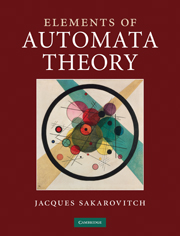I - THE SIMPLEST POSSIBLE MACHINE
from The three stages of rationality
Published online by Cambridge University Press: 05 September 2013
Summary
In the beginning, we de.ne automata as labelled graphs. This point of view enables a simple presentation of the basic properties of the languages recognised by .nite automata – called recognisable languages – and leads naturally to the successive generalisations which will be the subject of subsequent chapters.
We will then consider the family of recognisable languages as the result of a direct construction on the algebra of languages, that is, the set of subsets of a free monoid equipped with three operations, called rational operations. This is the substance of Kleene's Theorem, and the source of some of the properties of this family of languages which from now on we shall also call rational.
Next, we will return to automata but with a functional point of view which is more suitable for the modelling of a calculating machine. This leads directly to the notion of a deterministic automaton and on to that of a minimal automaton.
The fourth section is an introduction to the theory of rational expressions, which provides an axiomatic perspective on the construction of rational languages. This theory is only sketched, but its definitions allow us to compare different modes of calculation and to introduce the idea of the derivation of an expression, which is another means of linking rational languages and automata.
- Type
- Chapter
- Information
- Elements of Automata Theory , pp. 49 - 216Publisher: Cambridge University PressPrint publication year: 2009



